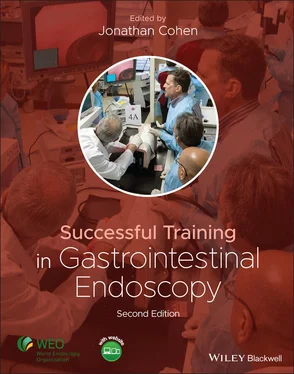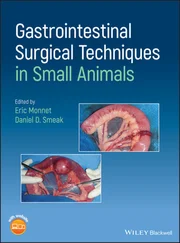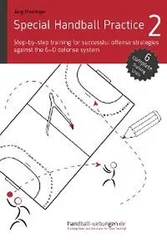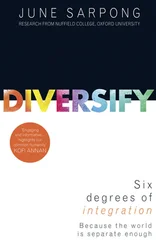Successful Training in Gastrointestinal Endoscopy
Здесь есть возможность читать онлайн «Successful Training in Gastrointestinal Endoscopy» — ознакомительный отрывок электронной книги совершенно бесплатно, а после прочтения отрывка купить полную версию. В некоторых случаях можно слушать аудио, скачать через торрент в формате fb2 и присутствует краткое содержание. Жанр: unrecognised, на английском языке. Описание произведения, (предисловие) а так же отзывы посетителей доступны на портале библиотеки ЛибКат.
- Название:Successful Training in Gastrointestinal Endoscopy
- Автор:
- Жанр:
- Год:неизвестен
- ISBN:нет данных
- Рейтинг книги:3 / 5. Голосов: 1
-
Избранное:Добавить в избранное
- Отзывы:
-
Ваша оценка:
- 60
- 1
- 2
- 3
- 4
- 5
Successful Training in Gastrointestinal Endoscopy: краткое содержание, описание и аннотация
Предлагаем к чтению аннотацию, описание, краткое содержание или предисловие (зависит от того, что написал сам автор книги «Successful Training in Gastrointestinal Endoscopy»). Если вы не нашли необходимую информацию о книге — напишите в комментариях, мы постараемся отыскать её.
Teaches trainee gastroenterologists the endoscopic skills needed to meet the medical training requirements to practice gastroenterology and helps clinical specialists refresh their skills to pass their recertification Successful Training in Gastrointestinal Endoscopy, Second Edition
Successful Training in Gastrointestinal Endoscopy, Second Edition
Successful Training in Gastrointestinal Endoscopy — читать онлайн ознакомительный отрывок
Ниже представлен текст книги, разбитый по страницам. Система сохранения места последней прочитанной страницы, позволяет с удобством читать онлайн бесплатно книгу «Successful Training in Gastrointestinal Endoscopy», без необходимости каждый раз заново искать на чём Вы остановились. Поставьте закладку, и сможете в любой момент перейти на страницу, на которой закончили чтение.
Интервал:
Закладка:
Despite all the advances in tools and methods of training detailed in this book, the importance of having wonderful mentors remains paramount to successful training in endoscopy. I have been particularly fortunate in this regard to have had not just one but many who have inspired me with their zest for teaching, expertise, and wisdom, and have blessed me as well with their friendship. Thanks to Sanjiv, Stuart, Dean, Fred, Greg, Paul, Norm, and Gabe. Along with my colleagues around the world, many of whom have kindly contributed to this book, they have given me a strong appreciation for the importance of training and of ongoing learning in this ever‐changing and exciting field.
Especially thanks to my family, to Cori, Juliette, and Ben for their tremendous understanding, encouragement, and support. With the great upheavals of 2020, I have never been so mindful and grateful for each of you.
Finally, this book is dedicated to ENJC, my parents, and original teachers, for their lifelong inspiration and for giving me the idea for this project. AEL(CFI)S!
About the Companion Website
This book is accompanied by a companion website:
www.wiley.com/go/cohen/successfultraining2e
The website includes Videos

1 Training in Endoscopy: A Historical Background
Jonathan Cohen 1and David A. Greenwald 2,3
1New York University Grossman School of Medicine, New York, NY, USA
2Mount Sinai Hospital, New York, NY, USA
3Icahn School of Medicine at Mount Sinai, New York, NY, USA
Introduction
Gastrointestinal endoscopy has grown increasingly more complex as the field has evolved over the past several decades, now requiring the practitioner to become proficient at many techniques. To perform high‐quality care, endoscopists often have had to devote time to learn new techniques as well as take care to continually maintain existing skills. As the technology and applications have progressed, so too have the methods by which individuals have learned to perform these procedures. In this chapter, we will trace the evolution in training from the self‐taught pioneers of the early days to the advent of formal proctored tutelage that remains the mainstay of training in this field. The chapter will also relate the emergence of numerous innovative learning tools that have already served to further transform training in gastrointestinal endoscopy. In particular, we will describe the development of simulator‐based instruction from the creation of realistic models to their validation and growing importance in endoscopic training. Lastly, we will address a number of novel principles of education in endoscopy that have paralleled the growing availability of these new teaching tools.
Standard training in endoscopy: then and now
Self‐training for gastrointestinal procedures was the mode by which many of the early endoscopists progressed, largely because devices and equipment became available for which there was no “expert” instruction. In general, this method is not appropriate any longer for training in standard procedures (i.e., colonoscopy, upper endoscopy) where sufficient proctoring is readily available. However, as newer techniques are introduced (i.e., endoscopic suturing, endoscopic mucosal resection (EMR), endoscopic sub‐mucosal dissection (ESD), stent placement, transluminal surgery), the question of how to satisfactorily teach these new skills becomes relevant [1]. In fact, “short courses” have been developed to review the cognitive and technical aspects associated with such procedures. American Society for Gastrointestinal Endoscopy (ASGE) guidelines concerning such “short courses” exist, and suggest them as a possible way for experienced endoscopists to acquire new skills, but reject such methods for initial training for “standard” endoscopic techniques such as colonoscopy, upper endoscopy, endoscopic retrograde cholangiopancreatography (ERCP), and endoscopic ultrasound (EUS) [2].
The need to impart the wisdom from the growing expertise with endoscopes was readily apparent to the pioneer generation of flexible fiberoptic endoscopy. As early as 1962, the then recently renamed ASGE conducted a symposium entitled “Teaching Methods in Gastrointestinal Endoscopy” in New York City [3]. Two years later, the ASGE formed a committee to examine the requirements for training endoscopists; the conclusions established training as a priority and created a framework that guided formal endoscopy training for many years to follow. Three items were required: (1) full training in medicine or surgery, (2) special training specifically in gastrointestinal (GI) endoscopy under the supervision of an appropriately skilled teacher, and (3) performance of an adequate number of procedures. Soon to follow was the first annual postgraduate training course.
These efforts at a national level have been complemented by a proliferation of local and regional efforts to promote training with local courses and lectures aimed to supplement the one‐on‐one supervised instruction of trainees in the endoscopy laboratory as well as keep practicing endoscopists up on all of the latest techniques and advances. In 1973, Jim Eddy, Jerry Waye, Hiromi Shinya, Sid Winawer, Paul Sherlock, Henry Colcher, David Zimmon, and Richard McCray met at the Yale Club in New York to discuss how they might disseminate their knowledge and excitement about colonoscopy and polypectomy to practicing gastroenterologists. The result was the formation of the New York Society for Gastrointestinal Endoscopy (NYSGE) and shortly thereafter, an annual endoscopy course initially designated, “A Day in the Colon.” In this case, a regional society was founded for the sole purpose of promoting training. The evolving role of societies in training is the subject of Chapter 38in this book. However, it is important to recognize that from the national to the local level, the endoscopic societies have provided the dedication, organization, and resources to innovate and advance the field of training.
Supervised performance of actual endoscopies remains the predominant mode of endoscopy education today. Such apprenticeship‐type relationships between mentor and mentee have evolved greatly from the autocratic and unidirectional flow of information characteristic of similar learning environments dating back to the Middle Ages ( Figure 1.1). Recognition and adoption of key concepts such as the benefits of learning in a reduced stress environment, the need for constructive feedback and interactive dialog, and the importance of gradually increasing autonomy of the trainee as skills progress are among the concepts that would make current trainee learning environments quite foreign to medical apprentices of earlier eras.
In the United States today, most instruction in the techniques of gastrointestinal endoscopy is accomplished in the setting of formalized training programs of 3 years duration, with additional training available for selected “advanced” procedures such as ERCP and EUS. Proctored teaching of endoscopic techniques within such highly structured environments has been the “traditional” training method in gastrointestinal endoscopy. Endoscopic skills are developed concurrently with the immersion of the trainee in a complete curriculum that encompasses the range of normal and abnormal functioning of the digestive system, GI anatomy, and pathology. Trainees learn the indications for endoscopy, diagnostic and therapeutic capabilities of endoscopy, technical endoscopic skills, and application of therapeutic endoscopic intervention all in the context of intensive active supervised participation in consultative gastroenterology, for both outpatients and hospitalized individuals. While many physical aspects of endoscope manipulation and even lesion recognition can be taught to individuals not versed in the science and art of caring for patients with gastrointestinal complaints and disorders, to date, patients and practitioners alike have recognized the value and requirement that endoscopy be performed by individuals trained in such a comprehensive fashion, something that in this day can only be achieved in formal gastroenterology and surgical training programs. For this reason, this remains a first principle of published ASGE training guidelines [4, 5].
Читать дальшеИнтервал:
Закладка:
Похожие книги на «Successful Training in Gastrointestinal Endoscopy»
Представляем Вашему вниманию похожие книги на «Successful Training in Gastrointestinal Endoscopy» списком для выбора. Мы отобрали схожую по названию и смыслу литературу в надежде предоставить читателям больше вариантов отыскать новые, интересные, ещё непрочитанные произведения.
Обсуждение, отзывы о книге «Successful Training in Gastrointestinal Endoscopy» и просто собственные мнения читателей. Оставьте ваши комментарии, напишите, что Вы думаете о произведении, его смысле или главных героях. Укажите что конкретно понравилось, а что нет, и почему Вы так считаете.












